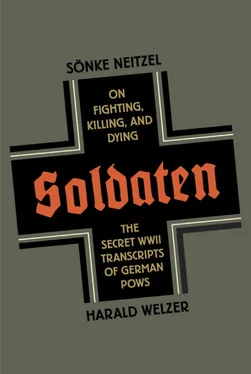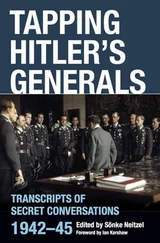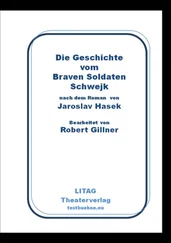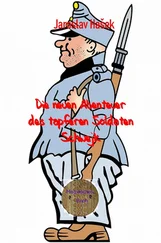The sailors’ stories revolve around the sinking of ships regardless of what type they were. Even navy men taken prisoner early on in World War II think in terms of this paradigm:
Bartz*: Would it not be better to try to pick off the destroyer first then the ships?
HUTTEL: No, always the tonnage space first; as that will be England’s destruction. The “Kommandant” always has to report at the B.D.U. (Befehlshaber der U-Boote—Commander in Chief U-boats) as soon as we return. We sink everything without previous warning, but they (the English) must not know that. {130} 130 SRX 34, 10 February 1940, TNA, WO 208/4158.
The excerpt was recorded on February 10, 1940, when the war was only a few months old. As of January 6 of that year, German naval command had allowed U-boat commanders in the North Sea to sink merchant vessels from neutral countries without warning, {131} 131 KTB SKl, Teil A, 6 January 1940, S. 37, BA-MA, RM 7/8.
a move intended to disrupt supplies traveling between Scandinavia and Great Britain. At the same time, submarine crews were to avoid attracting too much attention in order to head off international protests.
Of the six ships sunk by U-55 on its maiden patrol in January 1940, two were Norwegian and one was Swedish. U-boat crews didn’t care whom they sent to a watery grave. On the contrary, they spoke enthusiastically about new technological possibilities that would allow them to sink more ships. There was little room in their heads for thoughts about the fates of the crews on enemy ships. Saving enemies was only infrequently an option, and efforts to do so were correspondingly rare:
BARTZ: What do you do with the ships you sink?
HUTTEL: We always allow the crew to drown: what else can you do? {132} 132 SRX 34, 10 February 1940, TNA, WO 208/4158.
Sinking ships without warning significantly lowered the chances that anyone would survive attacks. On the 5,150 merchant vessels the Allies lost to German submarines in World War II, more than thirty thousand sailors were killed. {133} 133 Stephen W. Roskill, Royal Navy: Britische Seekriegsgeschichte, 1939–1945 (Hamburg: Stalling, 1961), p. 402ff.
German sailors did not need to be socialized in order to kill. No one questioned whether crews of enemy merchant vessels should have to die. Such “collateral casualties” had been an accepted part of naval warfare since 1917. Individual navy men had only limited opportunities to demonstrate their individual skill, bravery, or virtuoso handling of their machinery. If your ship was hit, you sank. If you hit someone else’s ship, that person went down. With that in mind, it is not surprising how ostentatiously detached and emotionless German navy POWs were when they told their stories of sinking ships and causing others to drown. The sailors didn’t want to let death get too close to them. Torpedoes are fired from a relatively great distance, and in contrast to fighter pilots, submarine crews rarely saw the results of their work. When a submarine launched a surface attack, there were usually only four men on deck, and the captain with his periscope was the only one who saw the target during an underwater attack. At most, the rest of the crew only heard the sounds of a ship sinking—hardly a basis for a great amount of empathy.
WAR CRIMES—OCCUPIERS AS KILLERS
Human beings’ understanding of what a war crime is has varied considerably from antiquity to the present day. There is no one standard as to what forms of violence constitute “normal” warfare. In light of the countless people who have lost their lives to war in the course of human history, it’s worth asking whether limits set on violence during wartime are the exception and not the rule. Conversely, there has never been a war, or for that matter any form of social behavior, that has been completely without rules. That includes World War II. The frame of reference of that conflict provided soldiers with a clear idea of what forms of violence were and weren’t legitimate—although soldiers did occasionally transgress such boundaries.
Nonetheless, the Second World War saw limits on violence, in both a qualitative and quantitative sense, removed to an unprecedented degree. More than any other conflict, World War II approximated the theoretical state of total war. {134} 134 See, e.g., Roger Chickering and Stig Förster, “Are We There Yet? World War II and the Theory of Total War,” in A World at Total War: Global Conflict and the Politics of Destruction, 1937–1945, Roger Chickering, Stig Förster, and Bernd Greiner, eds. (Cambridge: Cambridge University Press, 2005), pp. 1–18.
The experience of World War I continued to influence military discussions in the interbellum period, and many people saw the radicalization of war as unavoidable. The experts all agreed that the next war would be a total one. {135} 135 For more information and an international comparison, see Stig Förster, ed., An der Schwelle zum Totalen Krieg: Die militärische Debatte über den Krieg der Zukunft, 1919–1939 (Paderborn: Schoeningh Verlag, 2002).
Thus, despite no shortage of initiatives in that direction, there was no way to regulate or restrict the brutalization of armed conflict. The power of the major political ideologies, the general resistance to liberal ideas, the continued development of weaponry such as strategic bombers, and the intensifying plans for mass mobilization doomed all efforts to contain violence. {136} 136 See also Adam Roberts, “Land Warfare: From Hague to Nuremberg,” in The Laws of War: Constraints on Warfare in the Western World, Michael Howard, George J. Andresopoulos, and Mark R. Shulman, eds. (New Haven: Yale University Press, 1994), pp. 116–39.
Additionally, the experience of a number of armed conflicts between 1918 and 1939—the Russian Revolution, the suppression of uprisings in Germany, the Spanish Civil War, and the Sino-Japanese War from 1937 to 1939—diametrically opposed attempts to subject wartime violence to accepted rules. The adoption of the Second Geneva Convention on the humane treatment of prisoners of war was not enough to counteract this trend.
Much has been written about the horrible dimensions of unfettered violence in World War II, with many experts trying to explain it as the result of a combination of both situation and intent. Their reasoning draws comparisons with religious and colonial wars, maintaining that the ideologization of war prevented soldiers from recognizing the enemy as a fellow human being. Enemies could thus be killed on a whim. The perspective of the political and military leadership has been well documented, but the question remains: how did ordinary soldiers feel about these issues? What did they regard as war crimes, and which rules of warfare were anchored in their frame of reference?
The POWs in the surveillance protocols never refer to the idea of a war crime, or the Geneva Convention and the Hague Conventions of 1899 and 1907. Their decisive reference point was the customs of war, the things soldiers normally did in combat. From the onset of World War II, both sides engaged in unlimited submarine warfare, and tens of thousands of merchant marines lost their lives, even though they were not, strictly speaking, enemy combatants. Submarine crews generally offered them little assistance, since to do so would have been dangerous, and many navy men were indifferent to others’ fate. Nonetheless, it was a general rule not to kill sailors whose ships had been sunk—only a few exceptions are known. Prior to 1942, the German Luftwaffe was officially forbidden from launching “terror attacks” against exclusively civilian targets. But as we have seen, for bomber crews, the distinction between military and civilian targets had long been blurred. Everything was a potential target, even if that idea ran contrary to the official policy of the Luftwaffe high command. The exercise of violence modified the rules of combat and extended the boundaries of what was considered permissible. Tens of thousands of British civilians may have been killed in German air raids, and hundreds of British pilots shredded by German machine gun fire, but it was still taboo to kill a pilot who had ejected from his plane while he was parachuting to the ground. Tank crews who had abandoned their vehicles, on the other hand, were usually gunned down. Different rules applied in the air and on the ground, and though there were occasional violations, those rules retained their force. And since rules and customs of war were interdependent, international laws concerning war crimes were not completely ineffective. They still represented something of a frame of reference.
Читать дальше












